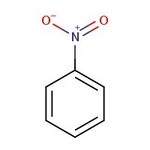Search Thermo Fisher Scientific
Thermo Scientific Chemicals
Nitrobenzene, 99%
CAS: 98-95-3 | C6H5NO2 | 123.111 g/mol
Catalog number ALFA10585.0E
View Price:Sign InSign in to see your account pricing. Need an account? Register with us today.
Quantity:
2500 g
Specifications
Chemical Name or MaterialNitrobenzene
CAS98-95-3
Health Hazard 1H227-H301+H311+H331-H350-H360F-H372
Health Hazard 2GHS H Statement
H300-H310-H330-H372-H351-H361-H227;
Fatal if swallowed.
Fatal in contact with skin.
Fatal if inhaled.
Causes damage to organs through prolonged or repeated exposure.
Suspected of causing cancer.
Suspected of damaging fertility or the unborn child.
Combustible liquid.
H300-H310-H330-H372-H351-H361-H227;
Fatal if swallowed.
Fatal in contact with skin.
Fatal if inhaled.
Causes damage to organs through prolonged or repeated exposure.
Suspected of causing cancer.
Suspected of damaging fertility or the unborn child.
Combustible liquid.
Health Hazard 3P201-P202-P210-P235-P260-P264b-P270-P271-P281-P301+P310-P302+P352-P304+P340-P308+P313-P311-P312-P330-P361-P363-P370+P378q-P501c
View more
Nitrobenzene is used as a solvent and as a starting material in the organic synthesis for the preparation of aniline, benzidine, azobenzene, nitrosobenzene, phenylhydroxylamine and acetaminophen. It is also used as a solvent for electrophilic reagents in synthetic chemistry. Further, it is used to prevent the unpleasant odor in shoe, floor and metal polishes. It acts as a precursor to rubber chemicals, azo dyes and pharmaceuticals.
This Thermo Scientific Chemicals brand product was originally part of the Alfa Aesar product portfolio. Some documentation and label information may refer to the legacy brand. The original Alfa Aesar product / item code or SKU reference has not changed as a part of the brand transition to Thermo Scientific Chemicals.
Applications
Nitrobenzene is used as a solvent and as a starting material in the organic synthesis for the preparation of aniline, benzidine, azobenzene, nitrosobenzene, phenylhydroxylamine and acetaminophen. It is also used as a solvent for electrophilic reagents in synthetic chemistry. Further, it is used to prevent the unpleasant odor in shoe, floor and metal polishes. It acts as a precursor to rubber chemicals, azo dyes and pharmaceuticals.
Solubility
Miscible with ethanol, diethyl ether, acetone, benzene and organic solvents. Slightly miscible with water and carbon tetrachloride.
Notes
Incompatible with strong oxidizing agents, strong reducing agents and strong bases.
Nitrobenzene is used as a solvent and as a starting material in the organic synthesis for the preparation of aniline, benzidine, azobenzene, nitrosobenzene, phenylhydroxylamine and acetaminophen. It is also used as a solvent for electrophilic reagents in synthetic chemistry. Further, it is used to prevent the unpleasant odor in shoe, floor and metal polishes. It acts as a precursor to rubber chemicals, azo dyes and pharmaceuticals.
Solubility
Miscible with ethanol, diethyl ether, acetone, benzene and organic solvents. Slightly miscible with water and carbon tetrachloride.
Notes
Incompatible with strong oxidizing agents, strong reducing agents and strong bases.
RUO – Research Use Only
General References:
- For selective reduction to phenylhydroxylamine with hydrazine hydrate in the presence of rhodium, see: Org. Synth. Coll., 8, 16 (1993).
- Electrophilic iodination of the deactivated ring has been effected with N-Iodosuccinimide, A14320, in triflic acid: J. Org. Chem., 58, 3194 (1993).
- Commonly used, high dielectric constant solvent, e.g. in Friedel-Crafts reactions. CAUTION! Exothermic reactions can occur with aluminum chloride.
- Fu, L.; Cai, W.; Wang, A.; Zheng, Y. Photocatalytic hydrogenation of nitrobenzene to aniline over tungsten oxide-silver nanowires. Mater. Lett. 2015, 142, 201-203.
- Boukobza, M.; Garnier, R.; Cleophax, C.; Baud, F. J. CT and MRI findings and follow-up after massive nitrobenzene ingestion. A case report. J. Neurol. Sci. 2015, 357 (1-2), 322-325.



